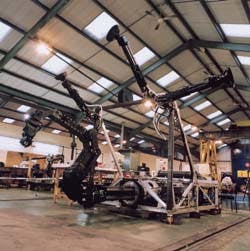Deepwater basin will hone diverless intervention techniques
Slingsby's ARM manipulator.
North East England's new centre for subsea technology is taking shape. Euro-Seas, based on a disused site in Blyth harbour, can now offer modern offices, workshops and a 60,000 sq ft fabrication shop.
Next door, Euro-Sea has also assumed management of British Gas' subsea engineering station. A £2 million investment is planned in a new test basin for this site, near to an existing 140 x 18 x 9 metre basin that incorporates a simulated seabed and a turbidity/current simulator.
Ove Arup and Gleeds have completed design studies for the new basin, which will be Europe's largest, measuring 70 metres long and 40 metres wide. Depth options are still under review: it could start off at 15 metres, ready for operation next year, but could subsequently be deepened progressively to 30 metres. That would be way beyond Marintek's deepwater technology test tank in Trondheim.
The new facility would be used for marinising deepwater production equipment, and for testing ROVs and associated tools in currents up to 6 knots. Relevant test rigs, including a wave tank facility, are already under construction. But the basin could also accommodate boats carrying booms for oil spill tests.
A 15 acre deepwater quay extension is also under way, and further down the harbour at Blyth, an 8.5 acre deepwater quay is available for bunkering or trials of large machines such as subsea ploughs.
Euro-Seas is a £10 million venture funded by the UK government, European Regional Development aid and numerous private and public sector partners. These comprise British Gas, TWI, the Northern Offshore Federation, Northumberland TEC and Blyth Harbour Commission. The aim is to attract designers, learned institutes and trainers to promote R & D into all types of subsea technology.
Even before the first phase of offices and workshops was complete, three tenants had already moved in. Transmark, which makes valves, pig traps, filters and separators, transferred its subsea engineering team down from Aberdeen. Dutch company CSD Sealings relocated its UK branch to the site; and Safety and Technical Training Services set up a UK administration and training facility.
Chris Pywell, Euro-Seas' managing director, expects further new tenants soon in the field of diverless intervention. "The R & D side is very important to us. We're putting together a capability in-house and in collaboration with other companies such as Brisco and Slingsby to provide one-stop intervention solutions."
At the turn of the year, the facility should also be ready for ROV training using work-class vehicles. TWI, which has its own eyeball ROV test tank on Teesside, will be the examination body. "This will be a mix of competence training, introductory and supervisory," says Pywell.
"There's only a need for approximately 100 new pilots a year: it's not a big business in its own right. But the training must be good. In the past there's been a tendency to offer short courses, but we'd be looking at much larger courses with more formal assessment."
Euro-Seas has been offered a project which would make use of ROVs for water-jet cutting of jacket legs and also to test a system for removing drill cuttings from the sea-floor. Here the British Gas test basin seabed simulator would be employed to replicate North Sea boulder clay, sand and gravel areas.
Remote engineering applications learning is another project. "We want to use knowledge engineering techniques to formally capture ROV pilots' conscious knowledge of subsea operations. We would turn their experience into formal knowledge and procedures, then incorporate that knowledge into subsea systems aiding ROV access for intervention and maintenance."
Other planned studies include `Microtech' - technologies for very small subsea fields with a three to four year production profile. "We're looking at equipment which would be reconfigurable, easy to operate and retrieve." Euro-Seas will also work with the Olympic Alliance team of Genesis Engineering Consultants, READ and Brisco, marinising their deepwater production prototypes and contributing intervention.
Robotic trials
One of Euro-Seas collaborators, Slingsby Engineering of Kirkbymoorside, Yorkshire, recently completed successful trials of the Advanced Robotic Manipulator (ARM) at Aberdeen's National Hyperbaric Centre. ARM has been sponsored by Mobil with a view to an inspection programme on its North Sea Beryl facilities.
ARM (co-developed by Technical Software Consultants) can be directed by a human operator with computer assistance, or automatically by the computer under operator supervision. The manipulator can reach areas beyond the scope of previous subsea tools, with the computer graphics providing a view of the manipulator as it works in areas out of sight of ROV-mounted cameras.
Key achievements of the trials included compliant docking with the MRV, which was attached to the side of the test tank via three vacuum feet; and docking of the toolskid without the ROV. This was done by lowering the skid with negative buoyancy to the tank floor and using the friction with the tank floor to enable the feet to clamp on. The whole skid was then walked up the structure using the hydraulic legs. Docking time was 5-10 minutes with the MRV and 30-60 minutes solely with the skid.
Other achievements were preliminary tuning of the ARM joint servo gains; fully automatic weld inspection using an ACFM array probe; and partial automatic weld inspection using a tracking ACFM probe. ARM took five minutes to deploy ready for inspection.
At ONS, Slingsby will demonstrate one of its TA40 STORM manipulator range, recently enhanced and now available in both rate control and master/slave, digital control modes with five, six or seven functions.
Copyright 1996 Offshore. All Rights Reserved.
